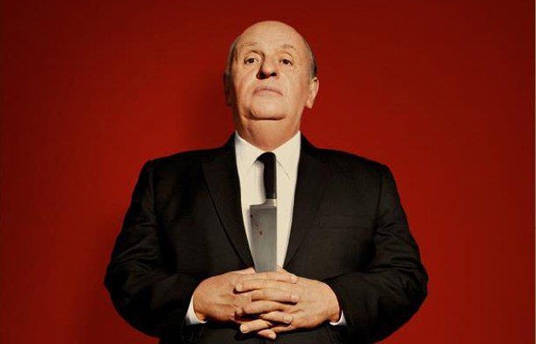DFI Film Review: Hitchcock
May 06, 2013

Opening Sacha Gervasi’s ‘Hitchcock’, a fire rages through the fields of Ed Gein’s farm, charring everything living and dead. With a sharp, striking motion from Ed’s shovel, his brother Henry is thrown to the ground, murdered. Cue music enter Alfred Hitchcock (Anthony Hopkins) to narrate this most heinous crime between brothers – one that echoes the mythic beginnings of mankind. Now we follow Hitchcock through the darkest chapter of his creative process – from the scene of the Gein crime, to the premiere of his ‘North by Northwest’ (1959) and finally … into his bathtub.
Capturing just one element of this iconic filmmaker’s legacy is a challenge few directors would take on. However, Gervasi enters Hitchcock’s world at full force, instantly setting the tone of the film by harking back to the monologues that began many of the celebrated director’s narratives. The cinematography and visceral filmic style of the man who brought audiences ‘The Birds’ (1963), ‘Vertigo’ (1958) and ‘To Catch a Thief’ (1955) – among dozens of others – is sutured into ‘Hitchcock’, paying homage to the legend.
Throughout the film, we catch Hitchcock peering around corners and through window blinds and holes in walls, becoming a voyeur of the film’s scenes and characters and scenes. These sinister scenes aren’t just clever shots designed by Gervasi; rather, they allude to Hitchcock’s ‘Rear Window’ (1954), which depicts a wheelchair-bound photographer (played by Hitchcock regular James Stewart) who, while spying on his neighbours, becomes convinced one of them has committed a murder. This element in the film means audience members who are familiar with Hitchcock’s body of work get an extra kick out of decoding Gervasi’s depiction of the master of suspense. (See below for our crash course in Hitchcock, should you need it!)
The mindscape of Hitchcock is displayed onscreen through numerous scenes that show Ed Gein (the killer on whom ‘Psycho’s (1960) Norman Bates is based) whispering into Hitchcock’s ear, providing advice and guiding his next move. The audience is often asked to step into the world of Gein through these interactions, as well as with photographs and meetings in the basement of Gein’s mother’s house. Blending real-life events with Hitchcock’s imagination, the film depicts how the director manifests his narrative; taking the knife into his own hands and eliciting the visceral scream of ‘Psycho’, which has echoed in the minds of viewers since it was first let loose in the cinema. All the elements of Hitchcock’s dark and humorous personality are revealed to the viewer as we follow his psychologically strenuous creative process – one that has given the world some of the greatest films of all time.
Following the production of ‘Psycho’ from the moment of inspiration to its premiere, many scenes point to the Hitchcock’s iconic status in cinema, and his ability to cleverly and seamlessly blend humour, horror and suspense. One of ‘Hitchcock’’s most powerful scenes takes place during the premiere of ‘Psycho’: During the buildup to the celebrated shower scene, in the lobby of the theatre, Hitchcock mimics leading the scene’s soundtrack, which soon turns into an chorus of screams; the rising and falling of his arms mirrors the intensity of the audience’s fear. In many respects, Hitchcock was a conductor of modern horror and suspense, creating symphonies of film that resonate to this day.
Gervasi’s use of profile shots and a scene where Hitchcock’s shadow is cast over the door of a dressing room ensure the audience is aware of key visuals that have been linked with the director’s unique style and his tendency to appear in his own films – his cameos appear in 39 of his 52 surviving films. The closing scene of the film mirrors its introduction – it once again shows Hitchcock looking directly into the camera, now inquiring what the subject of his next film will be … just as a menacing bird lands on his shoulder.
For any fan of Hitchcock’s legacy, there are plenty of scenes to stimulate a rush of nostalgia and give a glimpse into the mind of this master director. For those who want to learn more about the man behind the movies, check out this interview, as it will ensure that you have a ‘good evening’.
And here’s a crash course in Hitchcock – six films that are required viewing for any aficianado; six more if you really want to show off to your friends.
Six films for any Aficianado:
Rope
Six more films if you really want to impress your friends: